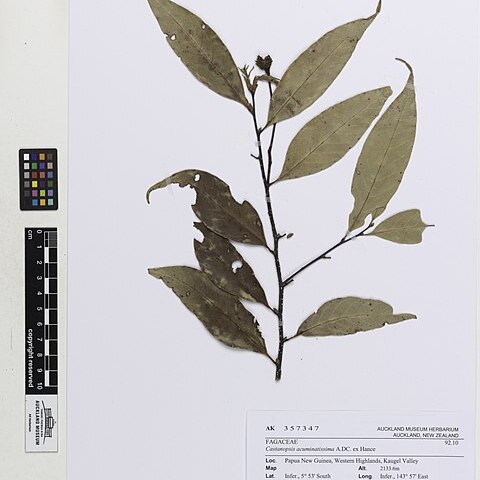Tree, 10-36 m by 30-90 cm ø; buttresses to 2 m tall, 1½ m out; bark greyish brown, rough, fissured, inner bark 1-2 cm thick, pale to reddish brown. Branchlets initially with a dense layer of rufous fimbriate scales and adpressed stellate hairs; slender, later glabrescent, with minute lenticels, greyish black, finely fissured, at the base with scars of the bud scales; terminal bud ovoid or flat-ellipsoid, mostly found when having attained a size of 4-8 by 2-3 mm, apparently waiting for some time before developing further, the scales imbricate or mostly distichous, membranous, ovate-acute, 1-1½ by 1-1.2 mm, densely hirsutely ciliate, persistent for some time. Stipules ovate-acute, 3-4 by 1 mm, caducous. Leaves thin-coriaceous, 4½-17 by 2½-6 cm (index 2.4-3.5 (-4)), widest at or below the middle; base rounded or attenuate, acute to sometimes decurrent, margin entire and undulate or remotely serrate in the apical half, top tapering and acuminate with sharp tip 1-2½ cm; surfaces discolorous, above glossy green, glabrous, underneath dull brown to sometimes silvery with a mostly thick cover of adpressed scales, no hairs; midrib and nerves prominent beneath, flattish or slightly sunken above; nerves 10-14 pairs at an angle of 45-60°, subparallel, ascending, arcuating and disappearing towards the margin, reticulation fine, scalariform or irregular, obscure on both surfaces; petiole ½-1 cm, adaxially flat. Inflorescences male, female, or androgynous. Male rachis 5-10 cm, slender with sparse simple hairs, bracts ovate-acute, membranous, 1-2 by 1-1½ mm, ciliate, bracteoles reduced to a cluster of simple hirsute hairs; ♂ flowers densely arranged but solitary, perianth lobes 6, almost free, ovate-rounded, 1-2 by 1½ mm, membranous, ciliate, stamens 12-14, filaments slender, 2-3½ mm, anthers 0.3-0.45 mm long, pistillode rudimentary, 1-1½ mm ø. Female and androgynous rachis 5-10 cm, slender, with sparse simple hairs, bracts ovate-acute, 1½-2 by 1-1.2 mm, membranous, densely ciliate, bracteoles 1 by 0.7 mm; androgynous rachis with a few ♂ flowers in the apical part; ♀ flowers solitary, perianth membranous, deeply incised, lobes 6,1-1.2 by 0.7 mm, densely hairy, staminodes 12, styles 3, recurved, cylindrical, 1-1½ mm, sparsely tomentose at the base. Young infructescence 10-15 cm, carrying 10-20 young cupules more or less ovoid-globose, sessile, enclosing the fruit except for the persistent perianth and styles, surface covered all over with scale-like appendages. Ripe cupule 1-1½ by 0.7-1.2 cm, (sub)sessile, more or less globose with the fruit partly emerging; wall ½-1 mm thick, inside sparsely hairy, outside densely grey-fulvous puberulous, rather densely set with acroscopical firm scales or small flat-triangular spines, irregular or in 5-7 ± regular transversal rows, to 2 mm long with a sharp glabrous tip or obtuse; dehiscence irregular or medianly into 2 equal segments. Fruit solitary, ovoid-conical, pointed, 1-1½ by ¾-1 cm, longitudinally ribbed (also in the fresh state?), scar flat or rounded, ± ¼ part, the remainder free, with dense rufous tomentum, glabrescent.
More
This tree grows up to 40 metres tall and it can have a trunk 1 metre through at the base. Most trees have several suckers growing from their base and the roots of the tree are close to the surface. It is a widely spreading tree. The bark is quite rough and yellowish. The leaves are mainly horizontal with re-curved tips. They are rich green on the upper surface and copper brown underneath. The male and female flowers occur separately but they both occur on the one tree. The tree has flushes of growth with new leaves having a slightly reddish colour. The fruit are borne on spikes 15 to 25 cm long carried near the ends of twigs. They are covered with a prickly envelope. The nut has a spiky type of covering around it and as it ripens this peels back and the nut falls. The nut is pointed, brown and slightly hairy. It is about 1.5 cm long and has two large "seeds" inside.


